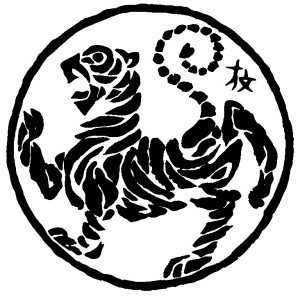The Shotokan Tiger
The Shotokan Tiger
 When Master Gichin Funakoshi created our system of martial arts, he chose the tiger as the animal symbol to represent Shotokan. He chose it because it signified strength, power, and tenacity.
When Master Gichin Funakoshi created our system of martial arts, he chose the tiger as the animal symbol to represent Shotokan. He chose it because it signified strength, power, and tenacity.
In those days, Japan was full of artisans and craftsmen. He could very easily have the tiger drawn to show it as a fierce, entire animal. However, he had it drawn with a series of lines, reminiscent of the tiger’s stripes, with no body outline.
If these lines were to be stretched out, they would hardly be recognized as representing an animal, but by compressing these lines, we see the outline of the tiger. He did it this way to show that our complete system is comprised of many parts and that all of these parts must come together to complete the entire system. These “parts??? are comprised of stances, strikes, thrusts, kicks, joint locks, pressure points, blocks, and throwing and controlling techniques. By combining parts of all of these techniques, we have the four main components of Shotokan: Kihon (basics), Kata (forms), Bunkai (self-defense), and Kumite (sparring).
But Gichin Funakoshi didn’t stop there. He had the tiger symbol drawn within a circle in order to show that the power of the tiger, much like to power of Shotokan, is contained. It indicates that we should never use this power on a whim. The power is only unleashed, or broken from the circle, in order to defend ourselves or others who cannot defend themselves from a violent attack.
When the average person thinks of the word “tiger,??? a variety of images come to mind. When the student of karate hears the term “Shotokan tiger,??? only one image comes to mind: the image formulated by Master Gichin Funakoshi.
Master Funakoshi was a scholar and a writer and he wrote under the pen name “Shoto,??? which literally means “Pine Waves.??? Today, Gichin Funakoshi is synonymous with the tiger symbol and Shotokan Karate-do. Few people, however, understand the relationship of “Shoto??? to what is commonly known as the Shotokan tiger.
When Gichin Funakoshi was a young man, he enjoyed walking in solitude among the pine trees which surrounded his home town of Shuri. After a hard day of teaching in the local school and several more hours of strenuous karate practice, he would often walk up Mt. Torao and meditate among the pine trees, under the stars and bright moon. Mt. Torao is a very narrow, heavily wooded mountain which, when viewed from a distance, the road going up the mountain resembles a tiger’s tail. In fact, the name “Torao??? means “Tiger’s tail.???
In later life, Funakoshi explained that the cool breeze which blew among the pines on Mt. Torao made the trees whisper like waves breaking on the shore. Because he gained his greatest poetic inspirations while walking among the gently blowing pine trees, he chose the pen name of Shoto, “Pine Waves.???
The tiger outline, used to represent Shotokan karate, is a traditional Chinese design that implies “the tiger never sleeps.??? It symbolizes, therefore, the keen alertness of the wakeful tiger and the serenity of the peaceful mind that Gichin Funakoshi experienced while listening to the pine waves on “Tiger’s Tail Mountain.???
